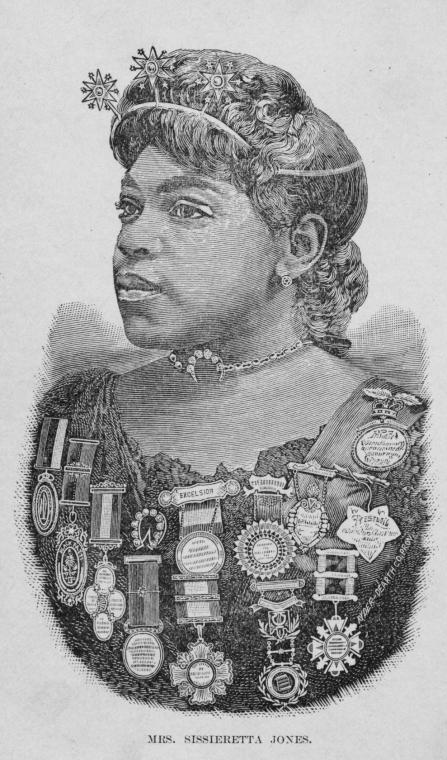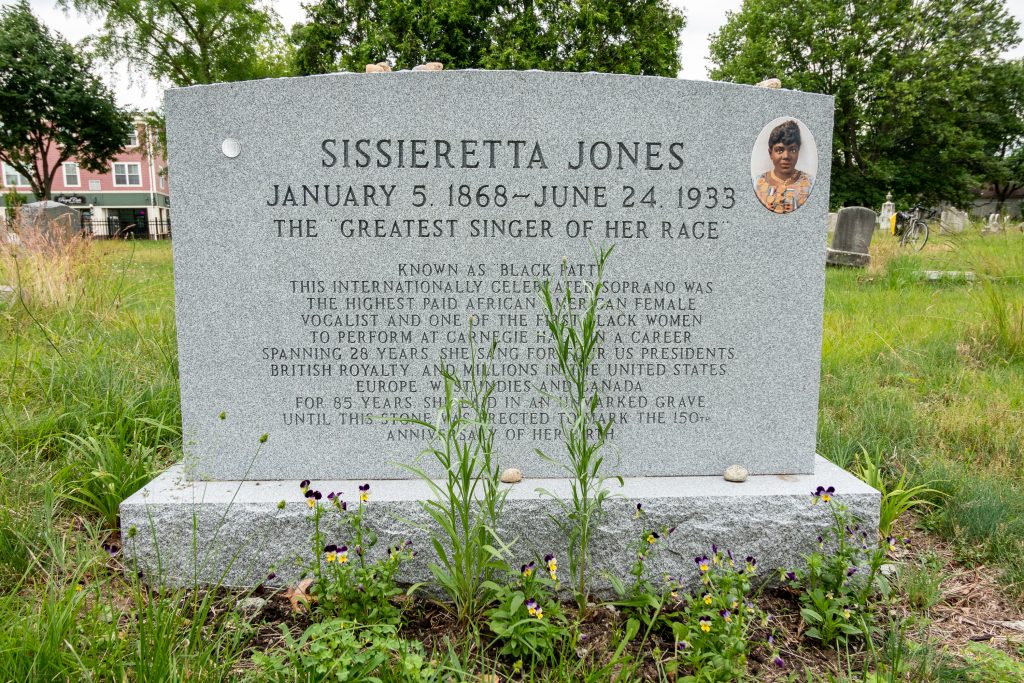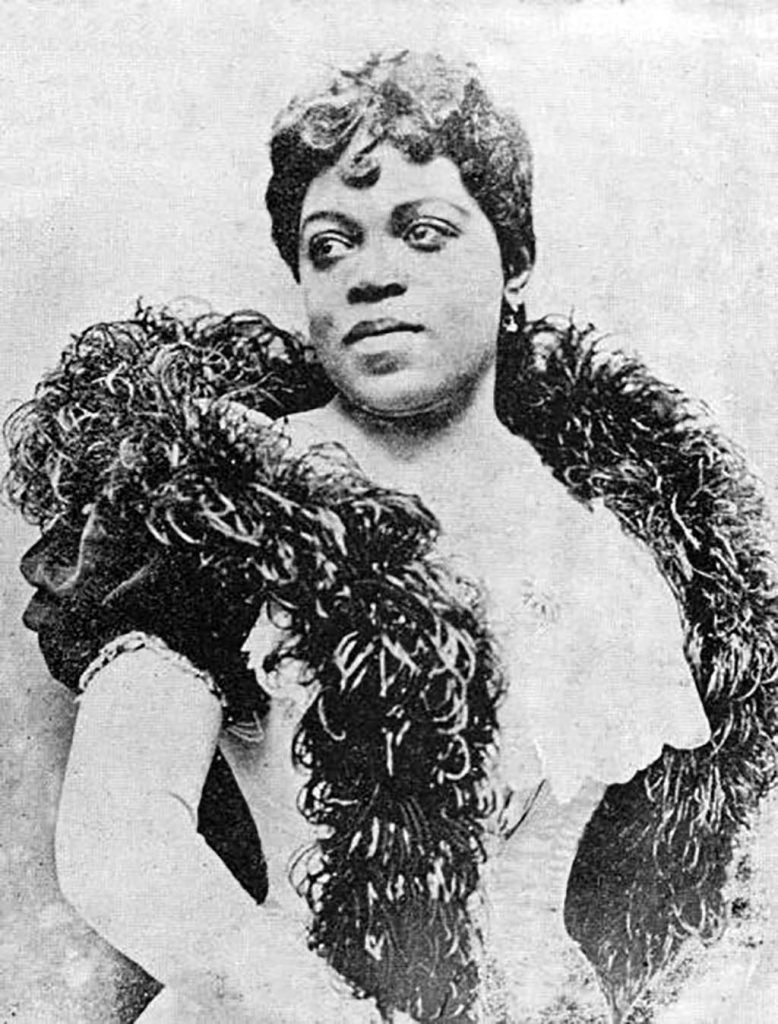
Grace Church Cemetery is a few blocks from my house. I like walking through cemeteries, I like reading the names, I like reading the inscriptions: There is one link that death cannot sever/ a loving remembrance lasts forever.
If you enter the cemetery on Elmwood Ave, one of the first headstones you’ll see reads: RICH KIDD. If you follow that path toward Broad Street, to your left, you’ll find the headstone for Sissieretta Jones – the greatest opera singer of her generation originally buried in an unmarked grave.
Matilda Sissieretta Joyner was born in Portsmouth, Virginia in 1868, three years after the end of the Civil War. Her formerly enslaved father worked as a minister, her mother worked as a washerwoman. In 1876, they moved to Providence. Her father was offered a ministerial position and Sissieretta began singing in the choir.
In an 1896 interview with the San Francisco Call, Sissieretta reflected, “It was after singing a little solo at a Sunday-school concert at Providence that some people said to my mother, ‘The child took a high C; you should let her learn music.’”
In 1883, at the age of 15, Jones attended Providence Academy of Music where she began formal voice training. That same year, she met and married hotel porter David Richard Jones. A year later, she gave birth to their daughter Mabel, who would soon die from pharyngitis and croup. In 1886, Jones continued her vocal training in Boston; afterward, she began performing in music halls throughout the Northeast.
Beginning in 1888, Sissieretta toured the Caribbean with the Tennessee Jubilee Singers, performing in packed concert halls filled with racially-mixed audiences. “Mdme. Jones, is the possessor of a pure and beautiful soprano. Her range of voice is as remarkable as it is even, and her enunciation and method display the most careful cultivation.” – Daily Gleaner (Kingston, Jamaica, August 13, 1888).


Jones was compensated handsomely – at her peak, she earned $2,000 a week and sang around the world to emperors, kings, princes, and four consecutive US presidents beginning with Benjamin Harrison. A newspaper review dubbed her “The Black Patti,” a comparison to the renowned Italian opera singer of the day Adelina Patti. Sissieretta disliked the moniker but her agent embraced it for its marketability, and reluctantly, so did she.
Admirers adorned her with brooches and medals made of gold and encrusted with diamonds and rubies, all of which she pinned to the chest of her elegant silk gowns before taking the stage with her perfectly coiffed hair and long evening gloves. In 1893, at the age of 25, she became the first Black woman to headline a concert at Carnegie Hall’s main stage. It was a benefit concert held for the World’s Fair Colored Opera and Concert Company. Frederick Douglass was scheduled to give the opening address. She performed Centemeri’s “Grand Aria,” an aria from Meyerbeer’s L’Africaine, and Gounod’s “Ave Maria.” Following her performance, a reviewer for The New York Times wrote “[Jones has] a voice of surpassing sweetness, a distinct enunciation, and a wide range… she easily held her vast audience spellbound from beginning to end.”
In 1895, her talent took her on a European tour. Emperor Wilhelm II saw her perform in Berlin. Albert Edward, the future King of England, attended her London debut. When passing through Rome, crowds gathered at the train depot just to catch sight of her, and then begged her to sing. Yet, despite her brilliance and international acclaim, she was barred from performing at the Metropolitan Opera House because of the color of her skin (a racial barrier that no woman would breach until Marian Anderson’s 1955 performance as Ulrica in Verdi’s A Masked Ball).
Sissieretta left Europe and returned to Providence to care for her mother, but by 1896 she was touring again, this time with the Black Patti Troubadours – a vaudeville show of 50 Black dancers, comedians, acrobats, and singers. However, 1896 was also the year of Plessy vs Ferguson, when the US Supreme Court upheld the constitutionality of Louisiana’s segregation laws, effectively ushering in a new era of racial violence and segregation known as Jim Crow. But Sissieretta didn’t relent.
From 1896 to 1915, Jones and her troubadours hit the road, traveling 42 to 45 weeks a year, performing in five to six cities a week, and facing segregation every step of the way. Jim Crow laws barred the Troubadours from staying at hotels, so they bought a train car for transportation and lodging. Segregation dictated how audiences could attend a performance – orchestra seats were reserved for whites only. Black audiences were restricted to balconies even when orchestra seats were left unoccupied.
Although a large portion of her repertoire consisted of operatic arias, Sissieretta was never permitted to sing for an opera company. In that same 1896 San Francisco Call interview, it was suggested Jones don wigs and make-up to transform her appearance, to which she replied, “Try to hide my race and deny my own people? Oh, I would never do that. I am proud of belonging to them and would not hide what I am even for an evening.”
In 1915 – the same year The Birth of a Nation was shown at the Providence Opera House, where it played to packed audiences for five weeks – Sissieretta Jones retired from the stage and returned to Providence to care for her mother.
At the time of her retirement, Sissieretta owned several rental properties, which she sold off one by one to generate income. Then, one by one, she sold off her treasures – her brooches and her medals. When she fell ill on June 14, 1933, she borrowed money for a cab ride to Rhode Island Hospital and died 10 days later. Impoverished, Sissieretta Jones was buried in an unmarked grave alongside her mother at Grace Church Cemetery.
On June 9, 2018, 85 years after her death, a headstone was erected thanks to the fundraising efforts of her biographer Maureen Lee in partnership with Providence-based Stages of Freedom.
In December 2018, I was invited to an event at the Southside Cultural Center directly across the street from Grace Church Cemetery. The event was a sneak preview of Charlotte Mangin’s PBS series UNLADYLIKE2020: Unsung Women Who Changed America. Mangin was touring the US cities of the unsung – yet legendary – women featured in her series. For Providence that meant profiling recordsetting mountaineer Annie Smith Peck and the greatest opera singer of her generation, Sissieretta Jones.
More Posts by The Author:
On the Cover: Sophie Foulkes
The Progress Flag & the Danger of Empty Gestures
Note from the Editors
Women’s Health & Education Fund: To ensure all Rhode Islanders have access to safe abortions and contraceptive care despite the cost
On The Cover: Fu’una


